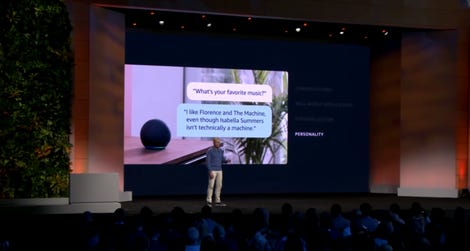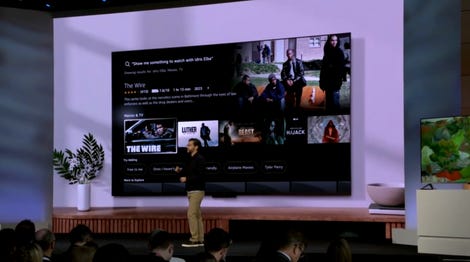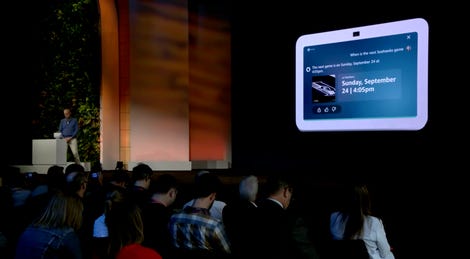AI: here are all the announcements of the Amazon conf

Wednesday evening Amazon organized its Amazon’s Devices & Services event, with many hardware announcements, but especially AI on the program.
Of course, Amazon is not at its first attempt when it comes to AI. His personal assistant Alexa has been for 10 years one of the most advanced and widespread examples of AI.
However, with the rise of generative AI models – much more advanced – the AI capabilities of Amazon’s voice assistant have become somewhat obsolete. And Amazon wants to change that.
The jewel in the crown of AI announcements is therefore a more conversational and more efficient Alexa, powered by a new, more powerful LLM. But AI has also been announced in new hardware, including the new Fire TV, the Echo 8, and much more.
ZDNET has collected all the most important and useful announcements about AI here.
1. What can Alexa do with her new LLM

Amazon/ZDNET
So Alexa was in dire need of an update. And it will now benefit from a transformation thanks to generative AI. The LLM under the hood allows in particular advanced conversation capabilities.
For example, Amazon claims that Alexa’s new “Let’s chat” function can do everything that the most popular generative AI chatbots can do, but in a hands-free context. Thanks to this function, users can ask Alexa to perform more creative tasks, such as telling a story, giving recipes, creating an idea for a date, or even providing the latest match results.
The new conversational capabilities of the assistant even allow users to interrupt him in the middle of the conversation and specify his message. These new features will be available on all Echo devices as part of a preview, even on the original Echo device shipped in… 2014.
These new features are also progress in terms of home automation. Thanks to the user’s voice, Alexa can create routines instead of having to configure a task manually on the app.
Alexa’s new conversational capabilities make it possible to deduce what users want to say about their home. This allows more latitude in the vocabulary used by the user.
2. Exploring with Alexa

Amazon/ZDNET
The “Explore with Alexa” function is a new addition to the Amazon Kids+ service that will allow children to participate in “child-friendly conversations with Alexa,” according to Amazon.
Thanks to this function, Alexa can provide children with answers to their questions. If your child wants to get away from the topic, the function has safeguards that allow Alexa to redirect the conversation to the appropriate content.
3. Eye Gauze with Alexa

Amazon/ZDNET
Available later this year on the Fire 11 Max tablet, the Eye Gaze on Alexa function will allow customers with mobility or speech impairments to use their gaze to interact with the tablet on predefined actions, without manual or voice intervention.
The tasks she can perform include playing music and shows, controlling the connected home and even making phone calls, according to Amazon.
4. Search on Fire TV

Amazon/ZDNET
With the new Fire TV Search, users can ask Alexa for Fire TV content through conversational queries, as if they were talking to a friend, instead of scrolling through their cursor for hours to find something to watch.
For example, users can request to see the content of an actor whose name they have forgotten or a movie of a specific genre, cost or theme, as well as other requests. This feature will be available through an update later this year.
5. The art of AI on your TV

Amazon/ZDNET
AI image generators are all the rage. And Amazon is now integrating this technology into its televisions. Users of the Fire TV 4K Max will be able to describe the art they want to see on the home screen of their TV, and in a few seconds the image will be generated and broadcast.
As with any other AI image generator, the possibilities are endless, the live demo even including a cyberpunk version of the New York Guggenheim.
6. Call translation

Amazon/ZDNET
Call Translation is a new feature that will allow Alexa’s audio and video calls to be subtitled in real time with the appropriate translation, thus allowing more people to participate in a conversation without language barriers.
As someone from a Spanish-speaking household who has to watch my friends say “I Do” to everything my grandmother says on the phone, I can’t wait to see how this feature works.
Subtitling will also allow deaf or hard of hearing customers to improve their phone calls.
7. Presence detection on Echo 8

Amazon/ZDNET
Depending on the user’s proximity to the Echo Show 8 connected speaker, the device automatically changes the way you see your home screen. The ability to detect the presence of a person can be considered as another example of AI.
When users are away from the device, they only have access to the essentials, such as a large clock. However, when they get closer to the Echo Show 8, the user interface becomes more detailed.
Source: “ZDNet.com “








